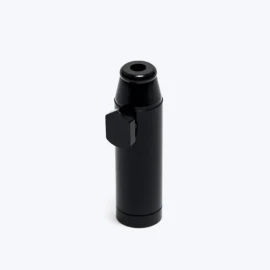Chocolate Haze
9,00 €
Strain Specifications
Type: Sativa-dominant (95% sativa / 5% indica)
THC Content: 18-23% (reports up to 25%)
CBD Content: 0.2-1%
Flowering Time: 8-10 weeks
Indoor Yield: 450-550 g/m² (up to 700 g/m² hydroponic)
Outdoor Yield: 500-900+ g/plant
Dominant Terpenes: Terpinolene, limonene, β-caryophyllene
Effects: Uplifting, creative, clear-headed
Duration: 2-3 hours
Best For: Creative professionals, musicians, depression/fatigue management, ADHD support
Genetic Heritage and Breeding History
The creation of Chocolate Haze represents a masterful intersection of old-school genetics and modern breeding techniques. This strain emerged from the careful crossing of two legendary varieties: OG Chocolate Thai and Cannalope Haze. The breeding program, which gained recognition in Amsterdam’s coffee shop culture before spreading to California’s cultivation scene, sought to preserve the distinctive chocolate characteristics of the Thai landrace while incorporating the soaring cerebral effects that define the Haze family.
OG Chocolate Thai contributes the strain’s signature chocolate and cocoa terpene backbone, delivering those rich, earthy notes that immediately distinguish Chocolate Haze from other sativa varieties. This parent strain brings centuries of genetic stability and the complex aromatic compounds that create the deep, satisfying chocolate flavor profile.
Cannalope Haze adds the essential Haze genetics that provide the strain’s characteristic mental clarity and creative stimulation. This parent contributes subtle melon and fruity sweetness that complements the chocolate base, while ensuring the effects remain consistently uplifting and cerebral rather than sedating. The Haze influence also contributes to the strain’s impressive vigor and substantial yields when properly cultivated.
What sets Chocolate Haze apart from other Haze varieties is this unique chocolate note combined with classic Haze clarity, creating a sensory experience that satisfies both flavor seekers and effect-focused users. The genetic stability achieved through multiple generations of selective breeding ensures consistent expression of both the chocolate terpene profile and the energizing effects.
Aroma and Flavor Profile — Terpene Analysis
Chocolate Haze delivers a complex sensory experience that unfolds in distinct layers, beginning with rich chocolate and cocoa notes that immediately capture attention. The primary aroma profile features deep, dark coffee undertones reminiscent of freshly ground cocoa beans, creating an almost edible quality that sets expectations for the flavor experience to come.
Secondary aromatic notes include bright fruity and melon accents inherited from the Cannalope Haze lineage, providing a refreshing contrast to the earthy chocolate base. Subtle citrus top notes add brightness and complexity, while gentle spice and earth undertones round out the profile with sophisticated depth.
Terpene Breakdown
Terpinolene (Dominant): Contributing 0.8-1.2% of the total terpene profile, terpinolene provides the strain’s distinctive citrusy, floral, and forest-like qualities. This terpene enhances the cerebral effects while adding complexity to the aroma with its multifaceted aromatic contributions.
Limonene: Typically measuring 0.3-0.6%, limonene delivers the bright citrus uplift that balances the heavier chocolate notes. This terpene supports the strain’s mood-elevating properties and contributes to the overall sense of mental clarity and focus.
β-Caryophyllene: Present at 0.2-0.4%, this terpene adds subtle spicy and peppery notes while potentially offering anti-inflammatory benefits. Its presence contributes to the strain’s therapeutic potential and adds depth to the flavor profile.
Total Terpene Content: 1.5-2.5%
The terpene expression can vary significantly based on growing conditions, with cooler nighttime temperatures during late flowering often intensifying the chocolate characteristics, while warmer conditions may emphasize the fruity and citrus notes. This variability allows growers to influence the final flavor profile through environmental manipulation.
Effects and Usage Scenarios
Chocolate Haze delivers a predominantly cerebral experience characterized by rapid onset and sustained mental stimulation. The effects typically begin within 5-15 minutes of consumption, starting with a gentle euphoric lift that gradually builds into full creative engagement. Users consistently report enhanced focus, increased motivation, and a clear-headed energy that makes this strain ideal for daytime use and productive activities.
Primary Effects
- Euphoric Onset: Quick-building happiness and mental uplift
- Creative Stimulation: Enhanced artistic thinking and problem-solving abilities
- Mental Clarity: Improved focus without racing thoughts or anxiety
- Energy Boost: Sustained motivation without jittery side effects
- Mood Enhancement: Significant improvement in outlook and emotional state
Duration and Intensity
Effects commonly last 2-3 hours, though individual tolerance and consumption method significantly influence duration. The experience maintains consistent intensity throughout, avoiding the peaks and valleys associated with some high-THC strains. Users report gradual, comfortable transitions both into and out of the effects.
Optimal Use Cases
Creative Professionals: Chocolate Haze excels as a pre-work strain for artists, writers, and designers seeking enhanced creative flow. The mental clarity prevents the scattered thinking that can accompany some sativa strains, while the creative stimulation opens new pathways for artistic expression.
Musicians and Performers: Many musicians report enhanced musical perception and improved improvisational abilities when using Chocolate Haze before practice or performance sessions. The strain’s ability to maintain focus while enhancing creativity makes it particularly valuable for complex musical tasks.
ADHD Management: Users with attention disorders often find Chocolate Haze helpful for short-term focus enhancement. The strain’s ability to provide mental clarity without overwhelming stimulation can support task completion and sustained attention when used responsibly.
Depression and Fatigue: The potent mood-lifting effects make Chocolate Haze valuable for individuals dealing with mild to moderate depression or chronic fatigue. The energizing properties can help overcome motivation deficits while the euphoric effects provide emotional relief.
Responsible Use Considerations
High-dose consumption may trigger anxiety in sensitive individuals, particularly those prone to THC-induced anxiety. Starting with small amounts allows users to gauge individual tolerance. The stimulating effects may interfere with sleep if used within 4-6 hours of bedtime, making timing an important consideration for evening users.
Laboratory Analysis and Cannabinoid Profile
Cannabinoid Content
THC (Δ9-tetrahydrocannabinol): 18-23% average, with exceptional phenotypes reaching 25%. This THC range provides substantial psychoactive effects while remaining manageable for experienced users. The consistency across batches demonstrates stable genetic expression.
CBD (Cannabidiol): 0.2-1.0%, contributing minimal body effects but potentially offering subtle anxiety-buffering properties without diminishing the sativa characteristics.
CBG (Cannabigerol): Typically 0.3-0.8%, this minor cannabinoid may contribute to the strain’s energizing effects and potential therapeutic benefits.
THCV (Tetrahydrocannabivarin): Present in trace amounts (0.1-0.4%), potentially contributing to appetite suppression and enhanced mental clarity.
Terpene Laboratory Data
Laboratory analysis consistently shows total terpene content ranging from 1.5-2.5%, placing Chocolate Haze in the upper tier for terpene preservation. The terpene profile remains remarkably stable across different growing conditions, though relative percentages may shift based on environmental factors.
Moisture Content: Properly cured samples typically measure 8-12% moisture content, optimal for long-term storage and smooth consumption.
Residual Solvents: Clean cultivation practices result in non-detectable levels of pesticides and solvents in quality samples.
Microbial Testing: Properly grown and cured Chocolate Haze consistently passes microbial safety standards when handled with appropriate post-harvest protocols.
Comprehensive Cultivation Guide
Growing Profile Overview
Chocolate Haze exhibits vigorous sativa growth patterns, characterized by substantial vertical stretch and long internodal spacing. The strain thrives in warm, dry climates and performs exceptionally well outdoors, though indoor cultivation is certainly achievable with proper space management and training techniques. Growers should prepare for significant height increases during the flowering transition and plan accordingly.
Growth Habit: Tall, stretchy sativa structure with long, flexible branches
Best Environment: Mediterranean climates; controlled indoor environments with height management
Difficulty Level: Intermediate to advanced due to stretch management and mold prevention
Training Requirements: Essential for indoor growing; highly responsive to LST and SCROG methods
Phase-by-Phase Cultivation Protocol
Seedling Stage (Weeks 0-2)
Lighting: 18-24 hours of gentle light daily, maintaining 200-400 PPFD to avoid stress while encouraging healthy establishment. LED grow lights at 24-30 inches distance work well during this delicate phase.
Environmental Control: Maintain relative humidity between 60-70% with temperatures around 72-76°F. Higher humidity supports rapid root development while preventing transplant shock.
Nutrition: Begin with quarter-strength nutrient solutions, focusing on nitrogen-rich formulations to support vegetative development. Avoid overwatering, which can stunt root growth and create damping-off conditions.
Training: Avoid aggressive training during this phase. Light LST can begin in week 2 if plants show strong establishment, but focus primarily on healthy root development.
Vegetative Stage (Weeks 2-5+)
Lighting: Maintain 18/6 light schedule with 400-600 PPFD. Chocolate Haze responds well to full-spectrum LED lighting that encourages compact node development during vegetative growth.
Structural Development: Begin topping at the 3rd-5th node for experienced growers seeking to control height. This strain responds exceptionally well to topping, producing multiple strong colas that help manage the eventual stretch.
Training Techniques: Implement Low Stress Training (LST) early and consistently. SCROG (Screen of Green) methods work particularly well with Chocolate Haze, as the flexible branches train easily and the strain produces excellent lateral growth when encouraged.
Nutrition: Provide balanced NPK nutrition with slight nitrogen emphasis. Boost micronutrients, particularly calcium and magnesium, which Chocolate Haze consumes readily during vigorous vegetative growth.
Duration Considerations: Vegetative time directly impacts final height. Indoor growers should transition to flowering when plants reach 12-18 inches, anticipating 200-300% height increase during stretch.
Pre-Flower Transition
Height Preparation: Ensure adequate vertical space before switching to 12/12 lighting. Chocolate Haze can easily double or triple in height during the first 3-4 weeks of flowering.
Nutritional Transition: Begin reducing nitrogen levels while maintaining phosphorus and potassium. Introduce bloom boosters gradually to support the coming flowering phase.
Environmental Adjustment: Begin lowering humidity gradually toward 45-50% to prepare for flowering requirements and reduce mold risk during the dense bud development phase.
Flowering Stage (Weeks 1-10)
Weeks 1-3 (Early Flower): Manage the significant vertical stretch with continued LST if needed. Remove lower fan leaves that will not receive adequate light. Maintain high airflow to prevent moisture buildup as bud sites begin forming.
Weeks 4-6 (Mid Flower): Focus on terpene development by maintaining stable environmental conditions. Avoid humidity spikes above 50% and ensure consistent air circulation around developing buds. This is when the characteristic chocolate aroma begins intensifying.
Weeks 7-9 (Late Flower): Reduce nitrogen feeding to near-zero levels while maintaining phosphorus and potassium support. Monitor trichome development closely as harvest window approaches. Begin flushing protocols in the final 1-2 weeks.
Week 10+ (Harvest Window): Chocolate Haze typically finishes between weeks 8-10, though some phenotypes may require additional time. Harvest when trichomes show mostly cloudy with 10-20% amber for optimal balance of effects.
Floral Support: Use stakes or trellising to support heavy colas, particularly in outdoor growing situations where wind can damage unsupported branches.
Advanced Optimization Techniques
Training Approaches:
- SOG (Sea of Green): Use many small plants with minimal vegetative time for quick turnaround
- SCROG (Screen of Green): Train 1-2 plants per square meter through screens for maximum canopy utilization
- Main-lining: Create symmetrical plant structures that maximize light penetration and bud development
Nutrient Management:
- Hydroponic Systems: Maintain EC levels between 1.2-1.8 during flowering, with pH between 5.8-6.2
- Soil Growing: Use organic amendments rich in phosphorus during flowering, maintaining soil pH between 6.0-7.0
Environmental Controls:
- Humidity Management: Keep RH below 50% during mid to late flowering to prevent bud rot
- Temperature Fluctuation: Provide 10-15°F temperature drops during dark periods in late flowering to enhance terpene production
- Air Circulation: Ensure strong airflow without direct wind on plants to prevent moisture accumulation
Harvest and Post-Harvest Protocols
Harvest Timing: Monitor trichomes with 60x magnification. Harvest when trichomes appear mostly cloudy with 10-20% amber for balanced effects. Clear trichomes indicate early harvest with more cerebral effects, while increased amber percentages provide more relaxing outcomes.
Drying Process: Hang whole plants or large branches in dark environment with 55-60% relative humidity and temperatures around 65-70°F. Proper drying takes 7-14 days and is crucial for preserving the delicate chocolate terpenes.
Curing Requirements: After initial drying, cure in sealed containers for minimum 2 weeks, though 4-8 weeks produces optimal flavor development. Chocolate Haze’s complex terpene profile continues developing during extended curing periods.
Troubleshooting Common Issues
Excessive Stretch: Reduce vegetative time, increase light intensity, implement early training, or use growth regulators if necessary. Prevention through proper planning is more effective than correction.
Mold and Bud Rot: Improve air circulation, reduce humidity below 45% in late flowering, remove dense fan leaf clusters, and thin canopy to improve airflow around bud sites.
Nutrient Deficiencies: Monitor pH levels regularly, test runoff EC levels, and adjust feeding schedules based on plant response. Chocolate Haze can be sensitive to nutrient lockout if pH drifts outside optimal ranges.
Slow Terpene Development: Reduce nitrogen in late flowering, provide cooler nighttime temperatures, avoid high-stress environments, and extend curing time to allow full terpene expression.
Medical and Therapeutic Applications
Primary Therapeutic Targets
Depression Management: Chocolate Haze’s potent mood-elevating properties make it valuable for individuals dealing with mild to moderate depression. The combination of euphoric effects and mental clarity can help break negative thought patterns while providing sustained emotional uplift. The strain’s energizing properties combat the lethargy often associated with depressive episodes.
Chronic Fatigue: The sustained energy boost provided by Chocolate Haze, without the crash associated with caffeine or other stimulants, makes it beneficial for chronic fatigue management. Users report improved motivation and ability to complete daily tasks when other treatments have proven insufficient.
ADHD Symptom Relief: Many users find Chocolate Haze helpful for short-term attention and focus enhancement. The strain provides mental clarity without the scattered thinking that can accompany some high-THC varieties, potentially supporting task completion and sustained attention when used judiciously.
Appetite Stimulation: While not as pronounced as with indica varieties, Chocolate Haze can provide mild appetite enhancement, particularly beneficial for individuals dealing with treatment-related appetite loss or eating disorders.
Terpene-Based Therapeutic Mechanisms
Terpinolene Effects: Research suggests terpinolene may contribute to the strain’s mood-elevating and energizing effects. This terpene’s interaction with the endocannabinoid system may support the strain’s antidepressant-like properties.
Limonene Benefits: Known for its potential mood-enhancing and stress-reducing properties, limonene contributes to Chocolate Haze’s therapeutic profile for anxiety and depression management.
β-Caryophyllene Activity: As a selective CB2 receptor agonist, β-caryophyllene may provide anti-inflammatory benefits without psychoactive effects, potentially supporting the strain’s therapeutic applications for inflammatory conditions.
Dosing and Safety Guidelines
Starting Dose: Begin with 0.25-0.5 grams when smoking or vaping, or 2.5-5mg THC equivalent in edible form. The strain’s potency requires careful dose titration, particularly for inexperienced users.
Tolerance Considerations: Regular users may require higher doses to achieve therapeutic effects, but frequent tolerance breaks help maintain sensitivity and reduce the risk of adverse effects.
Contraindications: Avoid use in individuals with active anxiety disorders, as the strain’s stimulating effects may exacerbate anxiety symptoms. Not recommended for those with cardiovascular conditions sensitive to increased heart rate.
Drug Interactions: Exercise caution when combining with other stimulants, including caffeine, as effects may be additive. Consult healthcare providers before use with prescription medications.
Consumption Methods and Product Applications
Flower Consumption
Smoking Characteristics: Chocolate Haze burns smoothly with minimal harshness when properly cured. The rich chocolate flavor translates well to combustion, though some terpenes may be lost to heat degradation.
Vaporization Optimization: Use lower temperatures (315-375°F) to preserve delicate chocolate terpenes. Higher temperatures (375-400°F) emphasize the strain’s energizing effects while potentially diminishing flavor complexity.
Concentrate Production
Extraction Efficiency: Chocolate Haze performs exceptionally well in light hydrocarbon extractions that preserve terpene integrity. Rosin pressing at lower temperatures maintains the characteristic chocolate profile better than high-heat methods.
Live Resin Production: Fresh-frozen Chocolate Haze produces outstanding live resin with intensified chocolate and fruity notes. The strain’s high terpene content translates well to concentrate form when processed immediately after harvest.
Dry Sift Quality: The strain’s resinous nature produces high-quality dry sift and bubble hash with excellent chocolate aromatics when processed gently to avoid excessive plant material inclusion.
Edible Applications
Decarboxylation Notes: Standard decarboxylation (240°F for 40 minutes) converts THCA to THC effectively while preserving some terpene content. Lower temperature, longer duration decarboxylation may better preserve the chocolate notes.
Flavor Pairing: The natural chocolate characteristics make Chocolate Haze ideal for dessert edibles, particularly those featuring dark chocolate, coffee, or mocha flavors that complement the strain’s natural profile.
Onset and Duration: When consumed as edibles, effects typically begin within 30-90 minutes and may last 4-8 hours, significantly longer than inhaled consumption methods.
Strain Comparisons
Chocolate Haze vs. Chocolope
Genetics: While both strains feature chocolate characteristics, Chocolope (Chocolate Thai x Cannalope Haze) emphasizes the sweet, candy-like melon notes more than Chocolate Haze’s earthy chocolate profile.
THC Content: Chocolope typically ranges 18-21% THC, slightly lower than Chocolate Haze’s 18-23% range.
Effects: Chocolope provides more relaxed, mellow effects compared to Chocolate Haze’s intense creative stimulation and energy.
Flowering Time: Chocolope finishes slightly faster at 8-9 weeks versus Chocolate Haze’s 8-10 week range.
Yield: Similar yield potential, though Chocolate Haze may edge ahead in outdoor environments with adequate space.
Chocolate Haze vs. Chocolate Thai
Heritage: Chocolate Thai represents one of Chocolate Haze’s parent strains, offering pure landrace genetics versus the hybrid vigor of Chocolate Haze.
THC Levels: Original Chocolate Thai typically measures lower THC (12-18%) compared to Chocolate Haze’s enhanced potency.
Flavor Profile: Chocolate Thai emphasizes earthy, pure chocolate notes without the fruity complexity added by the Cannalope Haze genetics.
Growing Characteristics: Chocolate Thai requires longer flowering periods (10-14 weeks) and may be more challenging to grow than the hybrid Chocolate Haze.
Effects: Chocolate Thai provides more traditional Thai landrace effects with intense cerebral stimulation, while Chocolate Haze offers more balanced, controlled energy.
Chocolate Haze vs. Cannalope Haze
Chocolate Presence: Cannalope Haze lacks the distinctive chocolate characteristics that define Chocolate Haze, focusing instead on melon and fruity flavors.
Potency: Similar THC ranges (18-22% for Cannalope Haze) but different effect profiles due to varying terpene compositions.
Medical Applications: Cannalope Haze may be better for anxiety-prone individuals due to its less stimulating effect profile compared to Chocolate Haze’s intense cerebral energy.
Cultivation: Both strains share similar growing challenges related to sativa stretch and environmental requirements.
Frequently Asked Questions
What is Chocolate Haze good for?
Chocolate Haze excels at providing creative uplift, sustained mental energy, and mood improvement without sedation. It’s particularly valued by artists, musicians, and creative professionals seeking enhanced focus and inspiration. Medically, it may help with depression, chronic fatigue, and mild ADHD symptoms when used responsibly under appropriate guidance.
How long does Chocolate Haze last?
Effects typically last 2-3 hours when smoked or vaporized, though duration varies based on individual tolerance, consumption method, and dosage. Edible forms may provide effects lasting 4-8 hours with different onset characteristics.
How long does Chocolate Haze take to flower?
Flowering time ranges from 8-10 weeks under controlled indoor conditions. Outdoor cultivation in suitable climates typically sees harvest readiness in early October. Some phenotypes may require additional time for full terpene development and optimal potency.
Is Chocolate Haze difficult to grow?
Chocolate Haze presents moderate growing challenges primarily related to managing significant vertical stretch and preventing mold during flowering. Experienced growers find it rewarding, while beginners may struggle with height management and environmental control requirements.
What terpenes dominate Chocolate Haze?
The primary terpenes are terpinolene (providing citrusy, floral notes), limonene (contributing citrus brightness), and β-caryophyllene (adding spicy complexity). Total terpene content typically ranges from 1.5-2.5%, creating the strain’s distinctive chocolate and fruity aroma profile.
Can Chocolate Haze help with medical conditions?
Users commonly report benefits for depression, chronic fatigue, and attention-related challenges. However, the strain’s low CBD content means it may not be suitable for conditions requiring significant CBD presence. Always consult qualified healthcare professionals before using cannabis for medical purposes.
What’s the difference between Chocolate Haze and other chocolate strains?
Chocolate Haze uniquely combines intense chocolate flavors with strong sativa effects, while many chocolate strains lean toward indica characteristics. The Haze genetics provide exceptional mental clarity and energy that distinguishes it from more sedating chocolate varieties.
How should I dose Chocolate Haze?
Start with small amounts (0.25-0.5 grams when smoking) due to the strain’s potency. The effects build gradually, so wait 10-15 minutes between doses to assess response. Those sensitive to THC or prone to anxiety should begin with even smaller amounts.
What growing environment works best for Chocolate Haze?
Warm, dry climates with low humidity during flowering produce optimal results. Indoor growing requires adequate vertical space and strong environmental controls. The strain performs exceptionally well outdoors in Mediterranean-type climates with proper support for heavy branches.
When is the best time to harvest Chocolate Haze?
Monitor trichomes with magnification and harvest when they appear mostly cloudy with 10-20% amber coloration. This timing provides the optimal balance of cerebral effects and chocolate terpene preservation that defines quality Chocolate Haze.
Related Products
Frequently Asked Questions
Everything You Need to Know















